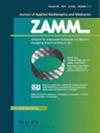Mathematical modelling of heat and solutal rate with cross‐diffusion effect on the flow of nanofluid past a curved surface under the impact of thermal radiation and heat source: Sensitivity analysis
IF 3.2
4区 工程技术
Q1 MATHEMATICS, APPLIED
Zamm-zeitschrift Fur Angewandte Mathematik Und Mechanik
Pub Date : 2023-07-11
DOI:10.1002/zamm.202300077
引用次数: 1
Abstract
This study analyses the effect of Brownian motion and thermophoresis on the flow of nanofluid along an impermeable curved surface. The Darcy‐Forchheimer drag vis‐à‐vis the radiating heat and the heat source enriches the flow phenomena. This drag force has several applications such as in (i) biomedical engineering for the flow of blood through curved arteries and veins, (ii) civil engineering for the flow of water through porous materials such as soil or rock, etc. The convective heat and solutal transport properties embedded in boundary conditions develop the heat transport phenomena. The dimensional governing equations are transformed into non‐dimensional form by using suitable substitution of transformed variables and stream function. Further, numerical practice is adopted to handle the set of nonlinear differential equations. The simulation of the optimized heat and solutal transfer rate for various factors is carried out using the ‘central composite design’ (CCD) associated with the ‘response surface methodology’ (RSM). The regression analysis and residual error are computed through the statistical approach of analysis of variance and finally, the sensitivity analysis is proposed for the various factors. However, the enhanced properties and flow behaviour for the diversified values of the physical parameters are presented and described briefly via the corroboration of the present methodology with the published work in particular cases. The notable outcomes are the axial velocity profile enriches for the increasing curvature constraints and the regression analysis is presented for the optimizing heat transfer rate using response surface methodology.热辐射和热源作用下纳米流体流过曲面时的热量和溶质速率与交叉扩散效应的数学建模:灵敏度分析
本文章由计算机程序翻译,如有差异,请以英文原文为准。
求助全文
约1分钟内获得全文
求助全文
来源期刊
CiteScore
3.30
自引率
8.70%
发文量
199
审稿时长
3.0 months
期刊介绍:
ZAMM is one of the oldest journals in the field of applied mathematics and mechanics and is read by scientists all over the world. The aim and scope of ZAMM is the publication of new results and review articles and information on applied mathematics (mainly numerical mathematics and various applications of analysis, in particular numerical aspects of differential and integral equations), on the entire field of theoretical and applied mechanics (solid mechanics, fluid mechanics, thermodynamics). ZAMM is also open to essential contributions on mathematics in industrial applications.

 求助内容:
求助内容: 应助结果提醒方式:
应助结果提醒方式:


